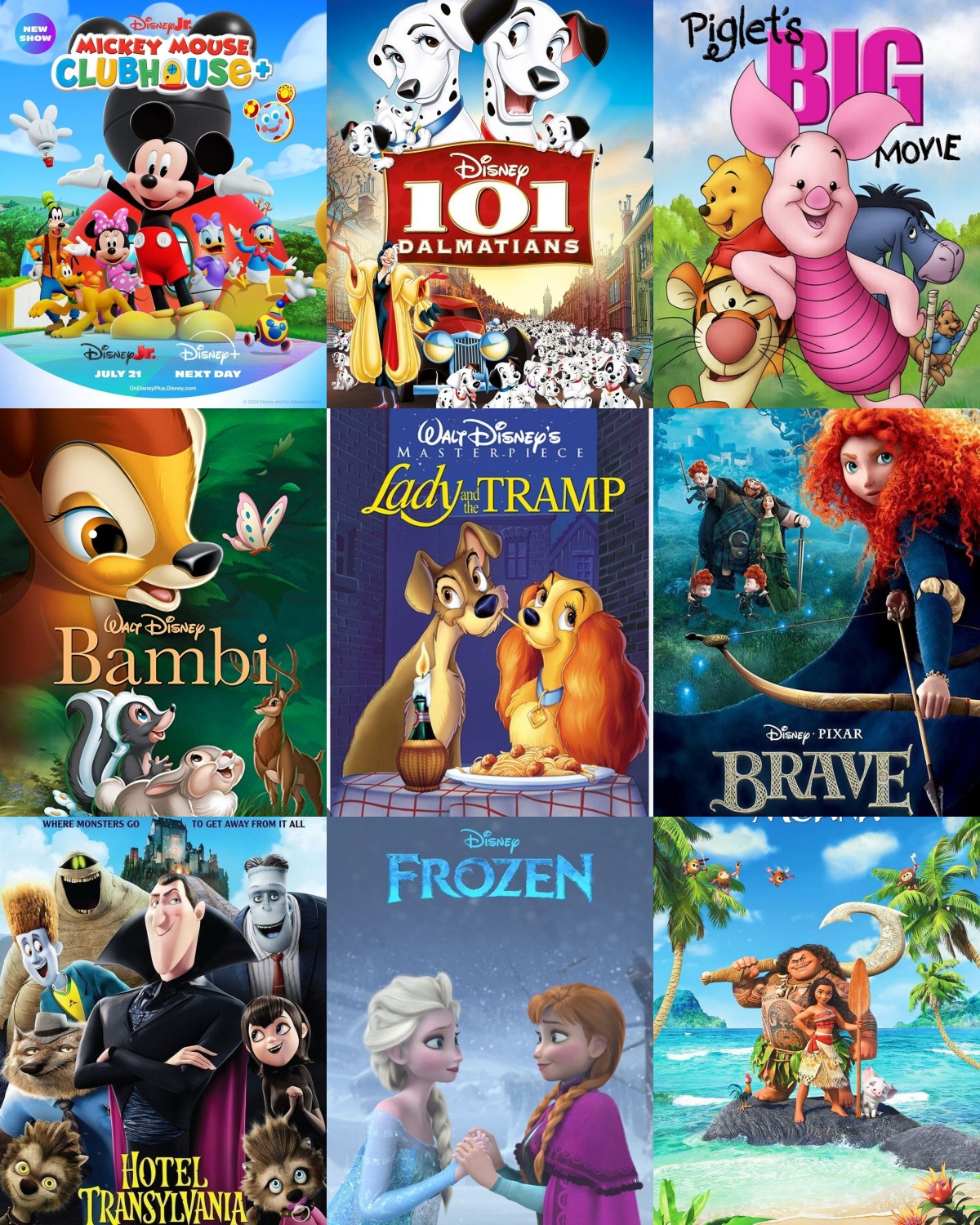From Mickey Mouse to Moana: Iconic Animated Movies Across Time

Related Movies:
Related Movies:
Related Movies:
Related Movies:
Mickey Mouse (1934):
By 1934, Mickey Mouse had already become a global icon, but it was in this era that he solidified his place as one of the most beloved and influential characters in animation history. At this time, Mickey’s adventures were becoming more sophisticated, and his appeal was growing far beyond the original short films that made him famous. In 1934, Mickey was at the height of his popularity, making appearances in a variety of animated shorts that were both innovative and entertaining, and some that are still fondly remembered today.
The most notable Mickey Mouse short from 1934 is The Wise Little Hen, which marked Mickey’s return to the silver screen. While Mickey was still a cheerful and mischievous character, this short was a turning point, as it introduced Mickey as a more prominent figure in longer and more developed storylines. The short also featured more vibrant animation and more dynamic visuals, showing the creative progress Disney was making in perfecting the art of animation.
Mickey’s charm was already evident by this time, and 1934 showcased his signature characteristics — his youthful exuberance, his friendly nature, and his adventurous spirit. Mickey was the embodiment of optimism, making him an appealing figure for both children and adults. His character was beginning to evolve beyond just a simple cartoon, becoming a symbol of fun, innocence, and joy.
The animation in 1934 was groundbreaking for its time. Mickey’s films featured more fluid movements, more detailed backgrounds, and better synchronization between the animation and the music, all hallmarks of Disney’s commitment to excellence. The inclusion of synchronized sound also helped to establish Mickey as a key player in the development of animation, paving the way for future classics.
Mickey’s supporting cast was starting to take shape as well. Characters like Minnie Mouse, Donald Duck, and Goofy began to show up more frequently, and the world of Mickey expanded, providing fans with more adventures and interactions between characters that would later become iconic in their own right.
1934’s Mickey Mouse represents a significant milestone in the character’s legacy. The animation was progressing rapidly, and Mickey’s character was becoming more defined, earning him a lasting place in the hearts of audiences. Mickey Mouse in 1934 is a reminder of how far animation had come and a preview of the even greater achievements Disney would go on to make in the decades that followed.
101 Dalmatians (1961):
101 Dalmatians is a delightful Disney classic that has charmed audiences for decades with its blend of heartwarming story, lovable characters, and unforgettable villain. The film follows Pongo and Perdita, two Dalmatian dogs who live with their owners, Roger and Anita. When their 15 puppies are kidnapped by the evil fashion-obsessed Cruella de Vil, the couple embarks on a thrilling adventure to rescue them. But the journey is no easy feat, as they must evade Cruella’s wicked plans and make their way across the English countryside to find their precious pups.
What makes 101 Dalmatians so beloved is the strong sense of family and loyalty that runs through the story. Pongo and Perdita’s determination to save their puppies is both touching and inspiring, while their devotion to each other showcases the power of love and partnership. The plot also introduces a host of lovable supporting characters, from the eccentric Colonel to the courageous Sergeant Tibbs, adding depth and charm to the film.
The animation in 101 Dalmatians is unique and striking, especially with its minimalist, sketch-like art style. The iconic spots of the Dalmatians are given great attention, making each dog feel distinctive. The film’s simple yet effective animation style captures the essence of the story, emphasizing the humor and action while providing a whimsical visual experience. The backgrounds are equally stunning, showcasing the beauty of the countryside and the danger of the perilous journey.
Cruella de Vil, voiced by the legendary Betty Lou Gerson, is one of Disney’s most memorable villains. Her over-the-top personality and obsession with fur make her both terrifying and darkly comedic. Her presence in the film provides a constant sense of tension and excitement as the Dalmatians race against time to outwit her and save their puppies.
The soundtrack, including the catchy and memorable “Cruella de Vil” song, enhances the film’s atmosphere and perfectly encapsulates the playful yet suspenseful tone. The film’s humor and lighthearted moments balance the darker themes, making it both entertaining and engaging for audiences of all ages.
101 Dalmatians is more than just a story about dogs; it’s about courage, teamwork, and the lengths to which one will go for family. With its unforgettable characters, charming animation, and iconic villain, the film continues to stand the test of time, remaining a heartwarming classic that resonates with viewers of all generations.
Piglet’s Big Movie (2003):
Piglet’s Big Movie is a heartwarming and charming adventure that focuses on the lovable, if sometimes overlooked, character of Piglet from the Winnie the Pooh series. In this feature-length film, Piglet embarks on an emotional journey of self-discovery, learning that even the smallest of individuals can make a big difference in the lives of others. The story is simple yet filled with heart, making it a delightful experience for children and nostalgic adults alike.
The plot centers around Piglet’s efforts to find his place in the Hundred Acre Wood when his friends are caught up in their own adventures, leaving him feeling left out and insignificant. When he goes missing, his friends, including Pooh, Tigger, Eeyore, and Rabbit, set out to find him. Along the way, they reflect on the small acts of kindness and the vital role that Piglet played in their lives — highlighting that even the tiniest of contributions can have a lasting impact.
The film’s animation stays true to the gentle, whimsical style of the Winnie the Pooh franchise, with soft colors and calm, peaceful settings that match the film’s soothing tone. The vibrant world of the Hundred Acre Wood is brought to life beautifully, with its lush greenery, simple joys, and cozy settings. The animation complements the lighthearted yet heartfelt nature of the story, drawing viewers into the timeless world of Pooh and his friends.
The film features a series of catchy, pleasant songs that help tell the story and provide an extra layer of emotional depth. These songs are easy to sing along to and contribute to the overall feel-good atmosphere of the movie. The soundtrack highlights themes of friendship, courage, and the importance of being true to oneself.
The voice cast, which includes Jim Cummings as Pooh and Piglet, delivers warm and endearing performances. The character of Piglet, voiced by Cummings, is particularly touching, capturing the character’s endearing shyness and deep love for his friends. The film’s themes of self-worth, friendship, and embracing one’s unique qualities are universal, making it resonate with both children and adults.
Piglet’s Big Movie is a sweet, gentle reminder that no matter how small you may feel, your presence and kindness matter in the world. It’s a touching film that emphasizes the value of friendship and the importance of appreciating the quiet but meaningful contributions we all make. With its lovable characters, soothing animation, and heartfelt message, it’s a wonderful addition to the Winnie the Pooh series.
Bambi (1942):
Bambi is a timeless Disney classic that remains one of the most beautifully animated and emotionally resonant films in the studio’s history. Released in 1942, it tells the poignant story of a young deer growing up in the forest, facing the joys and challenges of life, love, and loss. Through its simple yet profound narrative, Bambi explores universal themes of nature, growth, and the delicate balance between life and death, making it a powerful and moving film for all ages.
The story follows Bambi from his birth to adulthood, showcasing his experiences with the natural world and the animals around him, including his loyal friend Thumper the rabbit and the gentle, wise owl. As Bambi grows, he learns valuable lessons from his mother and his own experiences, navigating the challenges of survival in the wild. One of the film’s most unforgettable moments is the loss of Bambi’s mother, a heartbreaking event that serves as a powerful turning point in his journey and introduces one of the most emotionally intense scenes in animation history.
The animation in Bambi is exquisite, with soft, fluid movements and breathtaking depictions of the forest and its inhabitants. The lush landscapes and stunning natural settings are captured in exquisite detail, reflecting the beauty of the world that Bambi and his friends call home. The film’s watercolor backgrounds and delicate character designs create an atmosphere of serenity and wonder, immersing the viewer in the peaceful world of the forest.
The soundtrack, composed by Frank Churchill and Edward H. Plumb, beautifully complements the film’s natural themes and emotional tone. The music swells and softens with the moods of the story, helping to elevate the film’s most tender and dramatic moments. One of the most memorable aspects of the film is the music accompanying the famous scene of Bambi learning to walk and experiencing the joy of first love with his companion, Faline.
The voice acting is subtle yet effective, with the characters brought to life with warmth and authenticity. The characters of Thumper and Flower provide moments of comic relief, balancing the film’s more somber and serious moments. However, it is the performances of Bambi’s mother and father, who impart life lessons to the young deer, that leave a lasting emotional impact on the audience.
At its core, Bambi is a story about the cycle of life, growth, and the beauty of nature. It emphasizes the importance of family, resilience, and the harsh realities of the world, all while celebrating the beauty and fragility of the natural world. The film’s emotional depth, stunning animation, and timeless themes make Bambi a classic that resonates with viewers of all generations.
Lady and the Tramp (1955):
Lady and the Tramp is a heartwarming Disney classic that beautifully captures the themes of love, adventure, and the differences that make us unique. Released in 1955, this animated film follows the story of Lady, an affluent cocker spaniel, who lives a comfortable life with her owners in a suburban neighborhood. Her world is turned upside down when she meets Tramp, a scrappy mutt from the other side of town. As the two dogs embark on a series of adventures together, they begin to form an unlikely but deep bond, proving that love knows no boundaries.
The charm of Lady and the Tramp lies in its delightful characters, who are both lovable and relatable. Lady, voiced by Peggy Lee, is sweet, naive, and sheltered, while Tramp, voiced by Larry Roberts, is free-spirited, independent, and full of streetwise charm. Their contrasting personalities complement each other perfectly, and the film explores how their differences enrich their relationship as they get to know each other better.
The animation is warm and nostalgic, with beautifully designed scenes that capture the idyllic setting of the 1900s American suburbia, alongside the more rugged streets where Tramp lives. The film’s use of color and setting enhances the romantic and adventurous atmosphere of the story, making it feel both timeless and enchanting. The iconic spaghetti dinner scene, where Lady and Tramp share a plate of spaghetti and a kiss, is one of the most memorable and romantic moments in animated cinema, epitomizing the gentle, playful romance of the film.
The soundtrack features catchy and memorable songs, such as “Bella Notte” and “He’s a Tramp,” which perfectly complement the film’s tone and emotional beats. The music helps convey the film’s lighthearted moments as well as its more tender and reflective themes, adding a layer of emotion and charm that resonates with viewers.
The voice cast does a wonderful job bringing the animal characters to life. Lady’s elegance and innocence are well portrayed, while Tramp’s rugged but endearing personality shines through with wit and charisma. The supporting characters, like the jolly and loyal Jock and the wise and affectionate Trusty, add depth and humor to the story, enhancing the themes of friendship and loyalty.
At its core, Lady and the Tramp is a story about love, finding your place in the world, and appreciating the bonds we share with others, regardless of our backgrounds. The film’s beautiful animation, memorable music, and endearing characters make it a timeless classic that continues to capture hearts and inspire audiences of all ages.
Brave (2012):
Brave is a stunning Disney-Pixar film that beautifully combines adventure, humor, and heartfelt emotions into an empowering story of self-discovery and family. Set in the rugged Scottish Highlands, the film follows Merida, a fiery and independent young princess who yearns to carve her own path in life, free from the constraints of royal expectations. When her desire for freedom leads to a magical mishap that turns her mother, Queen Elinor, into a bear, Merida must find a way to undo the spell and restore her family’s bond.
At its core, Brave is a coming-of-age story that explores the complexities of mother-daughter relationships. Merida’s rebellious nature and her struggle to balance her own desires with her family’s expectations make her a relatable and dynamic protagonist. The film delves into themes of independence, bravery, and the importance of communication, as Merida learns that her actions have consequences and that true bravery often involves acknowledging the need for change and reconciliation.
The animation is nothing short of breathtaking, with the lush Scottish landscapes and intricate details of the characters’ environments. The breathtaking scenery, from the towering mountains to the foggy forests, adds a sense of adventure and mysticism to the story. Merida herself is a stunningly animated character, with her wild red hair and expressive face making her one of Pixar’s most visually dynamic heroines.
The soundtrack, composed by Patrick Doyle, features a stirring and emotive score that perfectly complements the film’s tone. The music enhances the magical and adventurous moments, while also underscoring the emotional depth of Merida’s journey. The iconic song “Touch the Sky” perfectly captures Merida’s desire for freedom and adventure, becoming an anthem of empowerment for anyone who has ever wanted to follow their own path.
The voice cast is excellent, with Kelly Macdonald bringing a perfect blend of warmth, vulnerability, and determination to Merida. Emma Thompson as Queen Elinor provides a wise and maternal presence, while Billy Connolly’s portrayal of King Fergus adds a touch of humor and charm. The supporting characters, including Merida’s mischievous triplet brothers and the mysterious witch, bring added layers of humor and intrigue to the story.
Brave is a beautiful and empowering film that emphasizes the value of family, understanding, and finding the courage to embrace who you truly are. Its stunning animation, memorable characters, and emotional journey make it a timeless Disney-Pixar classic that resonates with audiences of all ages.
Hotel Transylvania (2012):
Hotel Transylvania is a fun and quirky animated film that takes classic monster movie tropes and turns them on their head, offering a unique twist on the genre. Directed by Genndy Tartakovsky, the film is set in a lavish, monster-only hotel run by Count Dracula (voiced by Adam Sandler), who has built a safe haven for monsters to escape from the humans they fear. Dracula’s life is turned upside down when his daughter Mavis (voiced by Selena Gomez) turns 118 and decides she’s ready to explore the world outside of the hotel. When a human named Jonathan (voiced by Andy Samberg) stumbles into the hotel, Dracula goes to great lengths to hide his true identity and protect his daughter from falling for him.
What makes Hotel Transylvania so entertaining is its vibrant, slapstick humor and the heartwarming family dynamic at its core. The relationship between Dracula and Mavis forms the emotional backbone of the film, with Dracula’s overprotectiveness providing both comedic moments and touching insights into the lengths a parent will go to for their child’s happiness. The film’s humor is fast-paced, clever, and filled with visual gags, making it appealing to both children and adults alike. The monsters themselves are a delightful, eclectic mix of familiar characters — Frankenstein, the Mummy, the Werewolf, and others — who all add their own flavor to the film’s lively atmosphere.
The animation is bright, colorful, and full of energy, capturing the exaggerated expressions and chaotic moments that define the film’s tone. The hotel itself is a visually stunning setting, with fantastical and whimsical designs that add to the magic and fun of the story. Tartakovsky’s unique animation style, familiar from his work on Samurai Jack and The Powerpuff Girls, helps give the film its signature look, making it stand out from other animated films.
The voice cast is exceptional, with Sandler bringing a mix of humor and warmth to Dracula’s character. Andy Samberg’s portrayal of the goofy yet lovable Jonathan provides a perfect contrast to Dracula’s uptight and protective nature. The supporting characters, including Steve Buscemi’s werewolf and David Spade’s invisible man, add additional comic relief, making the hotel’s monstrous residents a joy to watch.
The soundtrack and musical score also add to the fun, with a lively, modern soundtrack that complements the zany energy of the film. The use of music and sound also enhances the film’s emotional moments, particularly in scenes where Dracula begins to realize that he must let go of his protective nature to allow Mavis to follow her own path.
Hotel Transylvania is an entertaining, heartwarming, and visually stunning film that will delight audiences of all ages. Its mix of humor, adventure, and heart makes it a standout animated movie that is as fun as it is heartfelt. With its lovable characters and charming story, it’s a great reminder of the importance of family, freedom, and accepting change.
Frozen (2013):
Frozen is a captivating Disney animated musical that became an instant classic, combining breathtaking animation, unforgettable songs, and a heartwarming story about love, family, and self-acceptance. Set in the icy kingdom of Arendelle, the film follows the journey of two royal sisters, Elsa and Anna. Elsa, born with magical powers that allow her to control ice and snow, isolates herself from the world to protect her loved ones. When her powers are accidentally revealed, the kingdom is thrown into eternal winter, and it’s up to Anna to find her sister and restore balance.
At its core, Frozen is a powerful tale about the bond between sisters. Unlike many traditional Disney princess stories, Frozen shifts the focus from a romantic love story to one about familial love, highlighting the strength and unconditional support between Anna and Elsa. This unique take sets it apart from other animated films, offering a fresh and emotional perspective that resonates with both children and adults alike.
The animation is nothing short of spectacular, with the wintry landscapes of Arendelle and the magical ice castles showcasing Disney’s incredible attention to detail. The snow-covered mountains, frosty forests, and Elsa’s mesmerizing ice powers are visually stunning, creating a magical world that feels both cold and beautiful. The animation’s fluidity, particularly in the action scenes and Elsa’s iconic “Let It Go” moment, is truly remarkable.
The soundtrack, featuring the Oscar-winning song “Let It Go,” is one of the standout elements of Frozen. The song, performed by Idina Menzel (who voices Elsa), became an anthem of empowerment, capturing Elsa’s internal struggle and her decision to embrace her true self. The entire soundtrack, with songs like “Do You Want to Build a Snowman?” and “Love is an Open Door,” is catchy, emotional, and perfectly complements the film’s themes of freedom, love, and self-discovery.
The voice cast delivers strong performances, with Idina Menzel bringing depth and emotion to Elsa’s character, portraying both her vulnerability and strength. Kristen Bell as Anna offers a perfect balance of warmth, humor, and determination, making Anna a truly relatable and lovable protagonist. Josh Gad’s portrayal of Olaf, the optimistic and endearing snowman, provides comic relief and adds lightness to the film, while also delivering some heartwarming moments.
Frozen stands out for its ability to entertain and inspire with a timeless message: that true love isn’t just about romance, but about the bonds we share with family and friends. It’s a film that encourages viewers to embrace who they are, accept their flaws, and celebrate their uniqueness. With its stunning visuals, memorable characters, and powerful soundtrack, Frozen is a film that will continue to captivate audiences for generations.
Moana (2016):
Moana is a visually stunning and emotionally rich Disney animated film that takes viewers on a captivating journey of self-discovery, bravery, and cultural pride. Set in the beautiful Polynesian islands, the film follows the story of Moana, a young girl who is destined to become the chief of her village. However, she feels a deep longing for the ocean and adventure beyond her island home. When her people face a crisis, Moana embarks on a daring voyage across the vast sea to find the demigod Maui and restore balance to the world.
At its heart, Moana is a story about finding your true purpose and embracing your destiny. Moana’s journey is one of self-discovery, where she learns that true leadership doesn’t come from following the expectations placed on her but from trusting herself and her unique abilities. Her courage, determination, and resilience are inspiring as she confronts obstacles that seem insurmountable, making her one of Disney’s most empowering heroines.
The animation in Moana is breathtaking. The vibrant, tropical landscapes, sparkling blue oceans, and lush islands create a visually rich world that is both magical and realistic. The fluidity of the ocean and the stunning sea creatures add to the beauty of the film, enhancing its sense of adventure and wonder. Every frame feels like a work of art, contributing to the film’s immersive atmosphere.
The soundtrack, composed by Lin-Manuel Miranda, Opetaia Foa’i, and Mark Mancina, is one of the film’s most memorable aspects. Songs like “How Far I’ll Go” and “You’re Welcome” are not only catchy but carry deep emotional weight that perfectly complements the film’s themes of bravery, self-discovery, and heritage. The music elevates the story, making it both uplifting and powerful.
The voice cast shines, with Auli’i Cravalho’s portrayal of Moana bringing depth and warmth to the character. Dwayne “The Rock” Johnson as Maui provides a mix of humor, charm, and vulnerability, making him both a larger-than-life figure and a relatable character. Their dynamic is one of the film’s highlights, with Moana’s determination and Maui’s arrogance providing both conflict and growth throughout their journey.
Moana is an empowering tale that celebrates adventure, heritage, and the courage it takes to challenge expectations. It’s a beautiful and inspiring film that resonates with audiences of all ages, offering messages of self-worth, perseverance, and the importance of embracing one’s culture. With its striking animation, powerful music, and unforgettable characters, Moana is a modern Disney classic that will be cherished for years to come.











